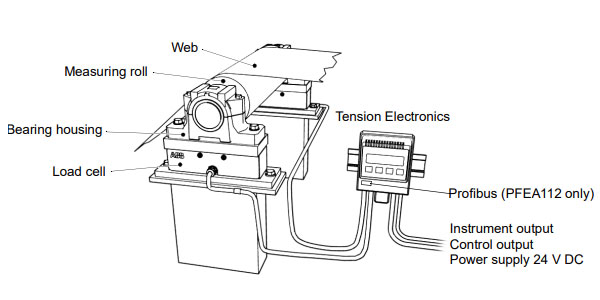PFEA 111, 112 and 113
– bringing something new to web tension
Covering a wide range of applications the Tension Electronics comes in three versions, with different levels of performance and functionality. All three versions have multi-language digital display and configuration keys. The configuration keys being used for setting different parameters and to check the status of the tension system.
The 2 x 16 character display can present sum, difference or individual load cell signals.
All three versions are available in both DIN-rail version and enclosed IP 65 (NEMA 4) version for mounting in more severe environments.
Your system for tension measurement consists of:
• Tension Electronics PFEA111 or PFEA112
– PFEA111 is a cost effective compact and user friendly tension electronics providing an accurate and reliable fast analog SUM signal from two load cells for control and/or monitoring. The display can show the SUM, individual A & B and difference signal. The small size and DIN-rail mount make this unit very easy to integrate into many types of electrical cabinets
– PFEA112 provides the same functionality and user friendliness as the PFEA111 with the addition of fieldbus communication via Profibus-DP. Covering a wide range of applications the Tension Electronics comes in three versions (The PFEA 113 is described in a separate manual), with different levels of performance and functionality. All three versions have multi-language digital display and configuration keys. The configuration keys being used for setting different parameters and to check the status of the tension system. The 2 x 16 character display can present sum, difference or individual load cell signals. All three versions are available in both DIN-rail version (IP 20-version, unsealed) and enclosed IP 65-version (NEMA 4) for mounting in more severe environments.
• Load cells of type PFCL 201, PFCL 301E, PFTL 101, PFTL 201, PFTL 301E and PFRL 101
The equipment is intended for use in a wide range of manufacturing processes where a web of any kind of material, e.g. paper, plastic or textile, is transported in a machine. The only requirement is that the web is wrapped over a roll. The force on the roll is proportional to the web tension. The resulting force is transferred through the bearing housings into the load cells. The load cells create a signal that is proportional to the force acting in the measuring direction of the load cells. This signal is processed and amplified in the tension electronics and can be used as an input signal for process control, presentation on a display or for registration
 中文版
中文版





